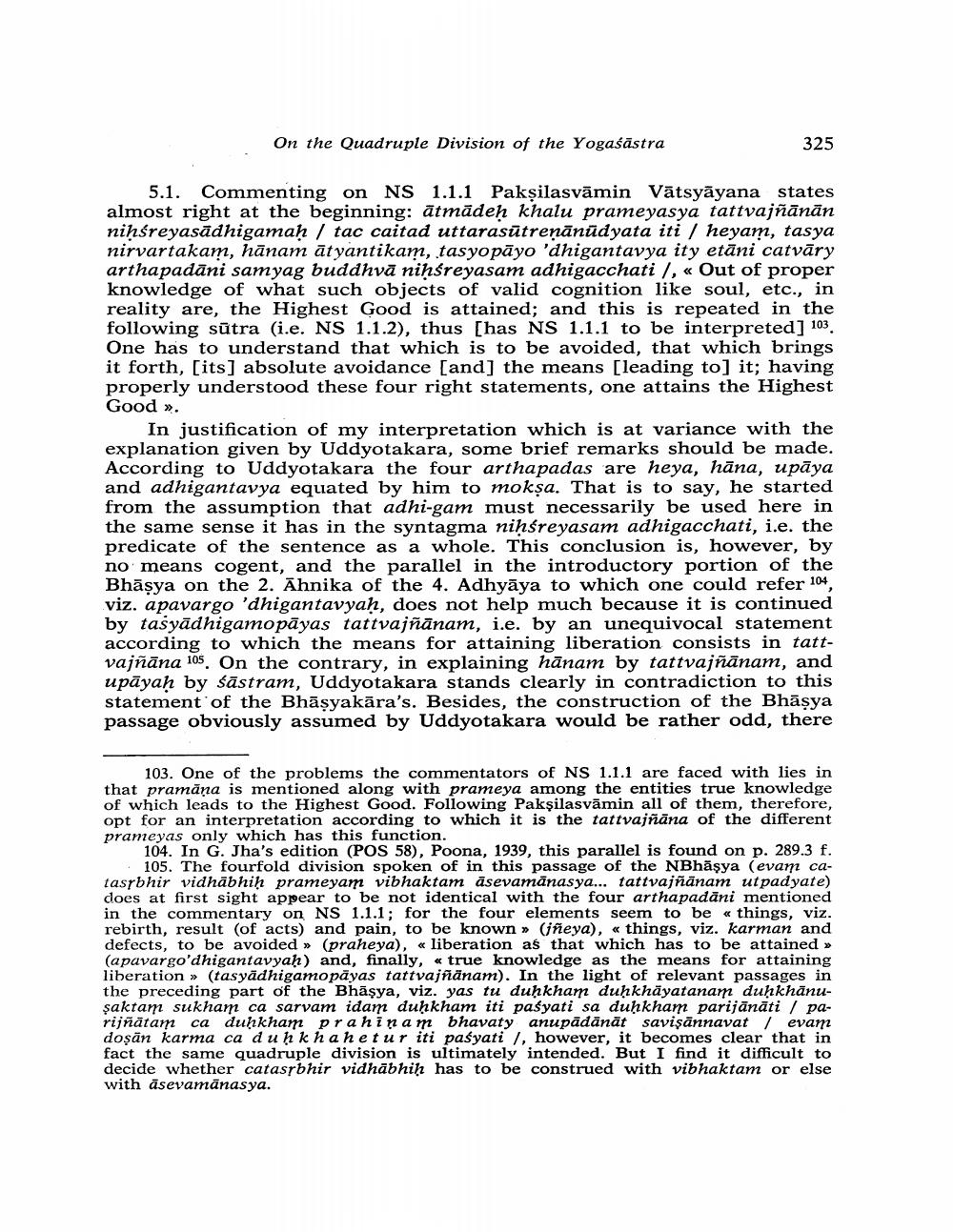________________
On the Quadruple Division of the Yogaśāstra
325
5.1. Commenting on NS 1.1.1 Paksilasvāmin Vātsyāyana states almost right at the beginning: ātmādeh khalu prameyasya tattvajñānān nihśreyasādhigamah / tac caitad uttarasütrenānūdyata iti / heyam, tasya nirvartakam, hānam ātyantikam, tasyopāyo 'dhigantavya ity etāni catvāry arthapadāni samyag buddhvā niņśreyasam adhigacchati /, « Out of proper knowledge of what such objects of valid cognition like soul, etc., in reality are, the Highest Good is attained; and this is repeated in the following sūtra (i.e. NS 1.1.2), thus [has NS 1.1.1 to be interpreted] 103. One has to understand that which is to be avoided, that which brings it forth, [its] absolute avoidance [and] the means [leading to] it; having properly understood these four right statements, one attains the Highest Good ».
In justification of my interpretation which is at variance with the explanation given by Uddyotakara, some brief remarks should be made. According to Uddyotakara the four arthapadas are heya, hāna, upāya and adhigantavya equated by him to moksa. That is to say, he started from the assumption that adhi-gam must necessarily be used here in the same sense it has in the syntagma niņśreyasam adhigacchati, i.e. the predicate of the sentence as a whole. This conclusion is, however, by no means cogent, and the parallel in the introductory portion of the Bhāsya on the 2. Ahnika of the 4. Adhyāya to which one could refer 104, viz, apavargo 'dhigantavyaḥ, does not help much because it is continued by tasyādhigamopayas tattvajñānam, i.e. by an unequivocal statement according to which the means for attaining liberation consists in tattvajñāna 105. On the contrary, in explaining hānam by tattvajñānam, and upāyaḥ by śāstram, Uddyotakara stands clearly in contradiction to this statement of the Bhāsyakāra's. Besides, the construction of the Bhāşya passage obviously assumed by Uddyotakara would be rather odd, there
103. One of the problems the commentators of NS 1.1.1 are faced with lies in that pramāna is mentioned along with prameya among the entities true knowledge of which leads to the Highest Good. Following Paksilasvāmin all of them, therefore, opt for an interpretation according to which it is the tattvajñāna of the different prameyas only which has this function.
104. In G. Jha's edition (POS 58), Poona, 1939, this parallel is found on p. 289.3 f.
105. The fourfold division spoken of in this passage of the NBhāşya (evam catassbhir vidhābhih prameyam vibhaktam āsevamānasya... tattvajñānam utpadyate) does at first sight appear to be not identical with the four arthapadāni mentioned in the commentary on NS 1.1.1; for the four elements seem to be « things, viz. rebirth, result (of acts) and pain, to be known » (jñeya), «things, viz. karman and defects, to be avoided » (praheya), « liberation as that which has to be attained » (apavargo'dhigantavyaḥ) and, finally, « true knowledge as the means for attaining liberation » (tasyādhigamopāyas tattvajñānam). In the light of relevant passages in the preceding part of the Bhāşya, viz. yas tu duḥkham duḥkhāyatanam duḥkhānuşaktam sukham ca sarvam idam dunkham iti paśyati sa duhkham parijānāti / parijñātam ca duhkham prahin am bhavaty anupādänāt savisānnavat / evam doşān karma ca dun k hahetur iti paśyati I, however, it becomes clear that in fact the same quadruple division is ultimately intended. But I find it difficult to decide whether catassbhir vidhābhih has to be construed with vibhaktam or else with āsevamānasya.




